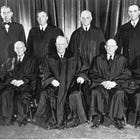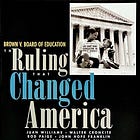Conversations: John Hope Franklin
In 2004 interview, acclaimed historian talks about helping on Brown v. Board case, state of race relations in U.S.
John Hope Franklin was one of the most influential and celebrated scholars and historians of the 20th century. His book, From Slavery to Freedom: A History of Negro Americans, was first published in 1947 and continually updated until Franklin’s death in 2009 at age 94. Never out of print, the book has sold more than 3 million copies.
Born in 1915 in Oklahoma, Franklin’s father was a civil rights lawyer known as the “Amazing Buck Franklin.” Buck was an eyewitness to the 1921 Tulsa race massacre, in which a white mob attacked African Americans and destroyed the Greenwood district that at the time was known as the “Black Wall Street.”
The younger Franklin, who graduated from Harvard University in 1941 with a doctorate in history, was teaching at Howard University when he was asked to serve on Thurgood Marshall’s NAACP team that was developing the legal arguments in Brown v. Board of Education.

In January 2004, I interviewed Franklin at First United Presbyterian Church in Charlotte, N.C.. where he had just finished a speech about the upcoming 50th anniversary of Brown. At the time, the 89-year-old Franklin was a professor emeritus at Duke University and was putting the finishing touches on his autobiography, Mirror to America, that was published the following year.
Franklin told me at the outset that he had time for only three questions — “Choose wisely,” he said with a smile — because he had to return to Durham for an engagement that evening. My regret is that I did not get to ask him more about his background or the many accolades — including the Presidential Medal of Freedom — that he had received during his long and illustrious career.
Below is the interview. To read more on John Hope Franklin, go here.
You spoke earlier today of working with Thurgood Marshall's legal team in the fall of 1953. What was that experience like?
The Supreme Court had asked some questions about the intent of states that had implemented the 14th Amendment. Those were historical questions, not legal questions. The lawyers had to present briefs to the court in December 1953, so I worked from Wednesday nights to Sunday nights at the NACCP's Legal Defense Fund offices on the nonlegal research staff.
Mostly it was working with documents — the state documents and congressional records and any other sources that would reveal some light about how the 14th Amendment could be used for the purpose of trying to desegregate the schools. We also were required to write papers dealing with some aspect of segregation and the history of it in the South.
It was a tedious but important task that we had to perform from day to day and week to week. I never thought I would get to the point where lawyers had so much respect from historians.
We worked hard, but if we worked hard, the lawyers worked even harder. I've never seen group of men in the legal profession working so hard. Thurgood was always there. Whenever I would go to New York and check in at the office, he was there. Whenever I would go to the office in the morning, he was there.
He had a steadfastness and determination to get the job done. We alwavs worked until midnight. At midnight, Thurgood said, "I think we should have a 15-minute break." I did not know then that his wife was dying, but she was. I later learned that it was wrecking him, but one would not have known it because he was always there.
Do you believe, as others have said, that Brown represented the start of the Civil Rights Movement in America?
I think the decision in Brown invigorated the Civil Rights Movement. It didn't start it, but it invigorated it. It set in motion forces and institutions that would use the decision in Brown and seek to carry it out. On the other hand, it gave opponents of desegregation new heart, new opportunities, and a greater determination to prevent the implementation of Brown with all of the energy and might that they could summon.
And so you have a continuation of the struggle that goes on today. On one hand, you have a remarkable growth of institutions as well as creeds that stand in favor of equality. But for every effort that is made to advance equality, history has shown that a countereffort is made to perpetuate (inequality]. You can't let up. You can't stop and celebrate victories. That's a lesson Brown has taught us.
You have said that the courts, especially the Supreme Court, have taken steps to turn back the promise of Brown. What do you think of this development?
You can't exorcise race. You can't simply wish it away. It's so ingrained in our Constitution, in our laws, and in our thinking that it is impossible to wish it away. You can talk about equity. You can talk about justice. You can talk about something that's tangible and real in our society. And that thing is race.
The law doesn't require people to love you. The law can require you to be treated equally. The law requires that if I move into the house next door to you that you can't try to run me out because of the color of my skin. It doesn't require you to speak to me or be nice to me, but it does require you to treat me civilly, and I have to do the same things for you. That's what the laws of the past 50 years have achieved. They require everyone to be treated equally.
This is one in a series of interviews — updated and in some cases now expanded — that marked the 50th anniversary of Brown v. Board of Education. The original interview was published in American School Board Journal in April 2004.






thank you Glenn for your update on this important issue